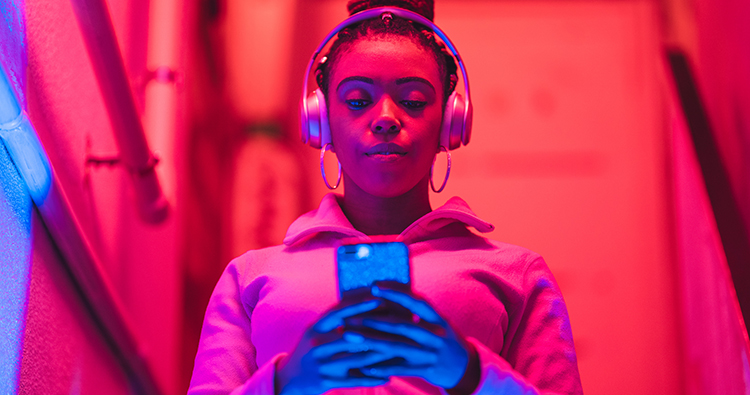Brands began marketing on audio platforms as early as 1922. Radio was the first audio-only space to be popular—and still is popular—audiobooks were first recorded in 1932, the post-World War II television boom happened in 1945, the internet became popular in the 1990s; later came podcasts in 2004, then streaming platforms in 2007 and satellite radio in 2008.
Although audio content marketing has been around for a long time, the industry continues to grow, and it’s not too late to join if you haven’t already. From podcasts to audiobooks and even audio marketing via social media, there is the potential to shake up your brand’s content marketing strategy. This article explores the state of audio content in 2024 and how brands can shake up their content marketing strategy in the audio sphere.

The Podcasting Landscape is Crowded but Still Thriving
As of 2022, there are over 3.2 million different podcasts and more than 181 million episodes in existence. Additionally, 62% of the U.S. population (approximately 177 million Americans) listens to podcasts regularly.
Brands can use podcasts to reach consumers and grow their business in a variety of ways such as sponsorships, ads and of course hosting their own branded podcast. Over 55% of listeners have made a purchase based on a podcast ad—which is the end goal.
If you’re skeptical about entering the podcast space, whether with an ad placement or by hosting your own branded podcast, the ROI is there. The podcast industry is predicted to grow to over $4 billion by 2024.
The horror-comedy show Last Podcast on the Left earns over $50,000 per month from Patreon. To put this into perspective, Last Podcast on the Left currently sits at #86 on the Spotify U.S. Top Podcasts chart. The earning potential is even higher for more popular podcasts. Podcasting has the potential to feed brands multiple revenue streams, such as ad placements, memberships and even live shows.
You must meet your consumers where they already are. More than 80% of podcast listeners (82.4% to be exact) spend upwards of seven hours on an average week listening on their favorite podcast app.
Branded Podcasts Are Alive and Well
Let’s get one thing clear, branded podcasts are not designed for you to bombard your audience with advertisements, sales pitches and product placements. They are a place to dive deep into topics surrounding your brand and industry. There are plenty of great examples of brands that are already doing this well.
Slack Variety Pack is a lifestyle show that includes 20- to 40-minute episodes covering work, life and everything in between. Each episode includes self-contained lifestyle stories all conveyed in Slack’s brand voice. Their focus is on modern society and company culture. Since Slack is a digital corporate communication company, their podcast’s topic perfectly aligns with their brand.
#LIPSTORIES by Sephora covers stories about influential female founders, creators and thought leaders throughout the professional world. Although Sephora is a makeup brand, the podcast focuses on female ingenuity, seeking to inspire a female audience while increasing awareness of the Sephora brand and giving it a powerful association.
Podcasts reached mainstream popularity between 2014 and 2018, but the number of people tuning into podcasts in general continues to gradually rise. Podcasting is one of the best ways to share your passion with your audience. Regardless of your product, service or industry, podcasting gives you the space to dive deep into the topics that matter the most to your brand and listeners.
Simply put, podcasting is low risk and high reward. For as little as $20 for microphones and sound mixers, you could join the countless podcasts steadily bringing in listeners, brand awareness and even cash. Through podcasting, you can deepen your relationship with your audience while also further growing that audience. In a way, podcasting is personal. Your audience can feel like they’re in the room with you—make your fans fall in love with you.

There’s Space for Content Marketing in the Audiobooks Ecosystem
The audiobook industry continues to grow year over year. Over $1.81 billion was generated through audiobook sales in the U.S. in 2022. Sales revenue for audiobooks in the U.S. increased by over 50% over the past five years.
With the audiobook industry continuing to rise, it’s a prime idea to publish a book and make it available on audiobook platforms like Audible and Google Play’s audiobooks. Forty-one percent of audiobook listeners subscribe to at least one audio subscription service. Additionally, 45% of Americans 18+ listen to audiobooks.
If you haven’t written a book necessarily, but you have published an article or a white paper, those can also be available within the audio landscape. With text-to-speech technology, previously print-only mediums are now more accessible. Sixty-two percent of Americans aged 18 and over use voice-assisted devices, while 100 million people own at least one smart speaker as of 2022. Smart speakers are yet another way to meet your audience where they are.
Despite the continuous growth of the audiobook industry, this is not a landscape that brands and content marketers are taking full advantage of. There will always be a need for educational editorial content, and audiences are eager to dive deep and learn new topics. But why are we not seeing traction in this area with brands in traditional industries like retail, health and banking—despite healthy audiobook activity in the tech and entertainment industries?
People buy books and listen to audiobooks from authors, and authors are real people. Literature is personal, whereas traditional brands heavily lean impersonal. If larger brands were to have a face—or a more transparent leader (like what we often see in tech giants) audiences would be keener on listening to an hours-long audiobook from their favorite CEO.

Social Media Audio Platforms Have Yet to Prove Valuable for Brands
Obviously with the continuous rise and undeniable success of preexisting audio content platforms, such as those for audiobooks and podcasts, social media audio platforms were bound to enter the picture.
Clubhouse Made Live Audio Cool—But Not for Everyone
Launched in 2020, Clubhouse changed the game because it was the first audio-only social media platform that allowed users to join virtual chatrooms and converse in real time. Upon its launch, the social media platform became viral because access was given on an invite-only basis. The COVID-19 pandemic also aided in Clubhouse’s virality because people were eager to connect while being isolated inside their homes due to the lockdown and restrictions.
Yet, the rapid success of Clubhouse just as swiftly declined due to several key factors. Clubhouse was placed under scrutiny due to its mishandling of security and privacy among other factors. The app was accused of being a breeding ground for hate groups and hate speech. Later, as COVID restrictions loosened and people began to be outside more, app usage declined. Then in 2021, the app lost its iPhone exclusivity and appeal. Today, the app is still available for download, but its appeal has faded compared to its competitors. Clubhouse remains at 10 million active weekly users (after its 2021 peak), compared to Twitter with 450 million monthly active users as of 2023.
Twitter Spaces Was One of Many Look-Alikes
To combat the popularity of the at-the-time viral social media platform Clubhouse, Twitter launched Twitter Spaces in 2020. Like Clubhouse, Twitter Spaces allowed users to engage in discussions in audio-only virtual chatrooms. Twitter Spaces was the only major social network to pose a threat to Clubhouse. Although initially successful, Twitter Spaces declined in its first year due to the brand’s massive layoffs.

Honorable Mentions
Clubhouse proved to be innovative, so much so that other live-audio social platforms began to emerge. Telegram introduced voice chat, Discord launched stage channels and Facebook rolled out its live audio rooms. Reddit also attempted to join the club along with new platforms like Riffr. Even LinkedIn and Spotify developed their own live audio experiences.
In discussing live audio platforms, we would be remiss not to mention recorded audio platforms like SoundCloud. Although SoundCloud arose as an artist-first platform focused on music, brands and individual users are able to upload other audio content types like podcasts.
With the continued rise of audio, it’s up to you to decide if these platforms are the right fit for your brand. The longevity and ROI of social media audio platforms are not impressive, but maybe your brand could be the catalyst of change.
Conclusion
Audio marketing is about reaching consumers where they are. In 2024, several avenues are available for your brand to venture through. What is the right strategy for your brand—placing ads in the audio space or positioning yourself as a thought leader by hosting your own branded podcast? The podcast industry has proven to be plenty lucrative, not even counting the other audio spaces such as audiobooks and smart home devices. It’s not too late to stake your claim in the audio space, as it appears to be here to stay.



